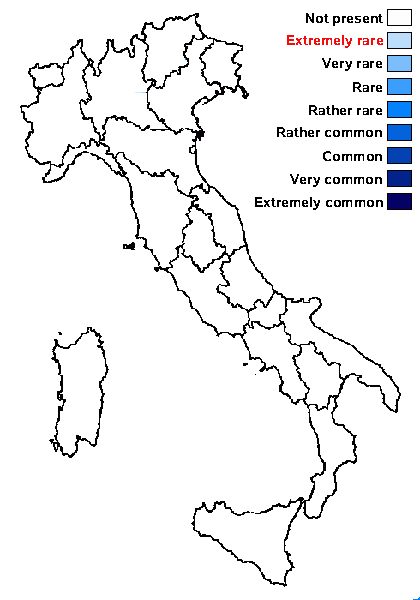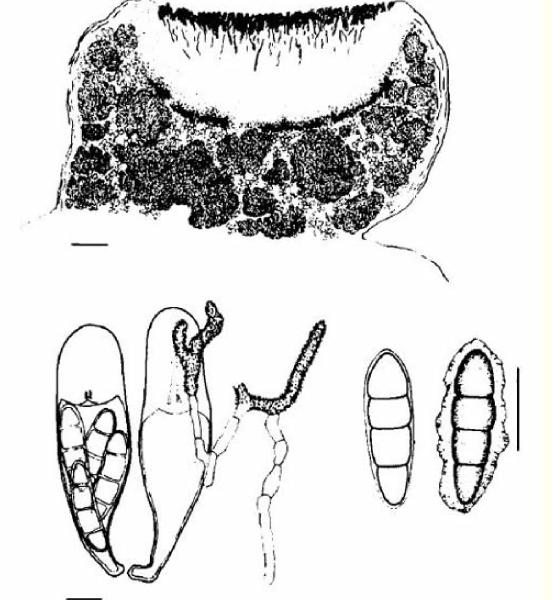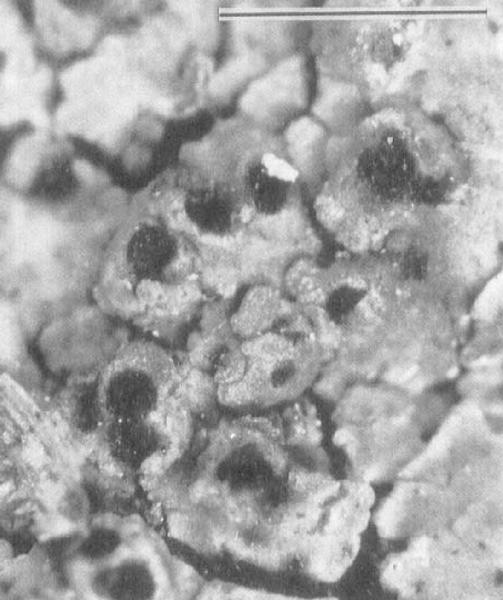Arthonia sampaianae (Diederich & Etayo) Ertz & Diederich
in Ertz & al., Bibl. Lichenol., 91: 123, 2005.. Basionym: Plectocarpon sampaianae Diederich & Etayo - Nordic J. Bot., 14, 5: 595, 1994.
Synonyms:
Distribution:
Description: Thallus inapparent, not lichenized, forming 0.5-1 mm wide gall-like formations on the thalli of Nevesia sampaiana. Apothecia arthonioid, single or in groups of 2-5, rounded, 0.2-0.5 mm across, dark brown to black, flat, sometimes subdivided into 2-3 loculi by excipular structures, without a proper margin. Proper exciple poorly developed, 20-30 μm thick, the excipular cells penetrating the host tissues in the center; epithecium brown, K+ orange-brown; hymenium brownish, 100-140 μm high, K+ olive, I+ red; paraphysoids branched and anastomosing, 2-4 μm thick, the apical cells pigmented, not markedly enlarged; hypothecium pale brown to colourless, 20-40 μm high. Asci 4-8-spored, clavate, semi-fissitunicate, with a large apical dome and a distinct ocular chamber, 60-90 x 17-21 µm. Ascospores 3-septate, slightly constricted at septa, at first hyaline then turning brown, ellipsoid, 20-26 x 6-8 μm, with a 0.5-4 μm thick perispore which becomes dark brown at maturity. Photobiont absent. Spot tests: K-, C-, KC-, P-. Chemistry: without lichen substances. Note: a lichenicolous fungus growing on the thalli of Nevesia sampaiana; known from several countries in Western Europe, to be looked for in Tyrrhenian Italy.
Growth form: Lichenicolous fungus
Substrata: bark
Reproductive strategy: mainly sexual
Most common in areas with a humid-warm climate (e.g. most of Tyrrenian Italy)
paras Nevesia sampaiana

Predictive model

Source: Diederich P. & Etayo J. - Taxonomic notes on the genus Plectocarpon (lichenicolous Ascom ycetina) - Nord. J. But. 14 (5) (1994)
holotype. Section through a
gall-forming ascorna, asci and paraphysoids with extracellular
pigment, ascospores (left: young, hyaline; right: old. brown). -
Scale 100 prn (ascoma), 10 prn (asci, spores).
Growth form: Lichenicolous fungus
Substrata: bark
Reproductive strategy: mainly sexual
Most common in areas with a humid-warm climate (e.g. most of Tyrrenian Italy)
paras Nevesia sampaiana

Predictive model

 INDEX FUNGORUM
INDEX FUNGORUM
 GBIF
GBIF


